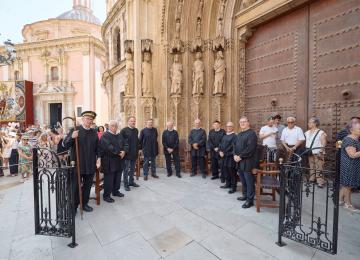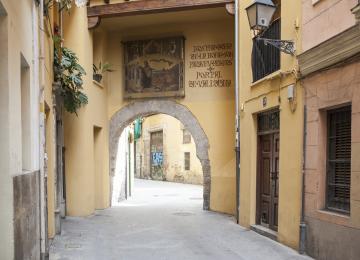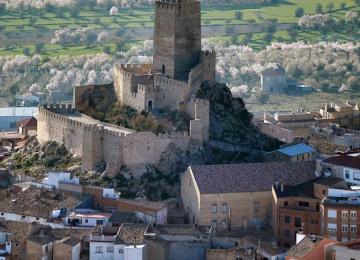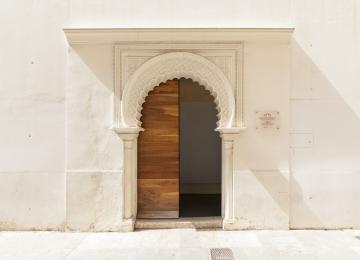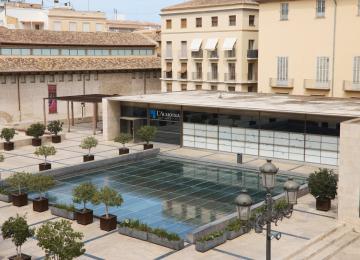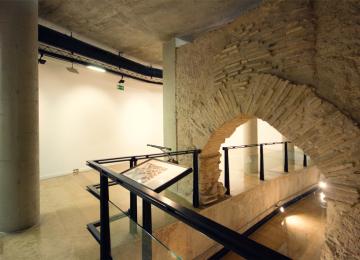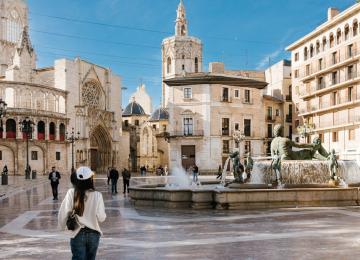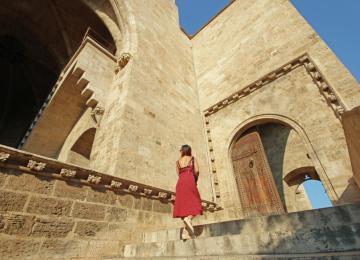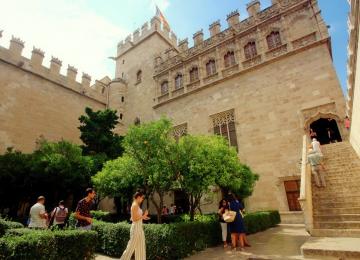The Apostles Gate of the Cathedral hosts the Water Tribunal, still active after a thousand years. It doles out justice through an oral process whose rulings can't be appealed. The Arabs relied on this irrigation system to allocate water from the Turia River.
Valencia's Arab legacy
Valencia's Arab legacy runs so deep that it extends beyond its architectural and monumental expressions. It remains entrenched in the soul of the city and its inhabitants. It is reflected in how Valencians are and live, in how they work the field and water it with an ancestral irrigation system. It is found in the language they use, in the place names of the metropolitan area… In a thousand details that showcase the indelible mark left on this land by more than five centuries of Muslim presence. Because before it was Valencia, it was Balansiya, a city that was loved and then longed for by Islamic culture.
The infinite light of a new era
The Muslims conquered Valencia in 714. They came in peace, which allowed them to live generously alongside the ancient inhabitants. In the first few centuries, the city remained politically irrelevant. At first it was known as Medina al-Turab (city of sand), although the name Balansiya soon came to be used to refer to the entire territory of this taifa (Muslim kingdom) integrated into Al-Andalus.
We know it was destroyed by Abd al-Rahman I, the first emir of Cordoba, to quell the revolt of an Abbasid Syrian army against his caliphate. However, it was his son, Abd Allah al-Balansi, who had a palace built on the outskirts with a large garden, the Russafa, which gave its name to the current neighborhood. The new culture took over and brought to the region half a millennium of wealth and prosperity. Agriculture evolved at an impressive pace. New crops were brought in, such as citrus fruits, rice and saffron, and the ditches used to irrigate them were wisely managed, giving rise to the fertile Horta. The Water Tribunal, which settles disputes between water users to this day, is a direct legacy of their decisive presence. The Arabs also brought us their number system, the development of mathematics and a fondness for gunpowder and music that we identify with so much. You need only experience the Fallas to the beat of the dolçaina and tabalet to see the mark they left. We are also indebted to them for that most Valencian custom that is present in every self-respecting celebration, namely throwing sweets, gifts or candies out onto the street. Their imprint is also seen in fishing techniques, such as the traditional redoli or calà method, passed down from generation to generation in l'Albufera, and in the Spanish and Valencian languages, with thousands of roots that are today reflected in the names of municipalities and instruments, a sonic expression of their influence. As the people who introduced paper to the West, for a long time they managed to make the paper made in Xàtiva the most prized in the world. Just like the silk fabrics produced in their looms, the blue ceramics with metallic reflections or the magnificent socarrat tiles that we can still admire today made by master craftsmen in Manises and Paterna, or in the González Martí National Museum.
Ceramics Museum. Marqués de Dos Aguas Palace
Discover its spectacular façade sculpted in alabaster and enter the magnificent rooms of the palace where authentic artisanal jewels from the National Museum of Ceramics await you.
The final days of Balansiya
The greatest moment of splendor of Arab Valencia came with the enthronement of Abd al Aziz in the year 1021. His reign gave birth to the Taifa of Balansiya, which lasted for more than four decades. His great legacy was the construction of a walled perimeter, much admired throughout Al-Andalus, and which stood until the Christian expansion of the 14th century. Decades later, and after El Cid's short stint as the city's lord and master, the Islamic rule passed from the Almoravids to the Almohads, but without the clout of the years of greatness. They were the last Muslim administrators, and would soon see their prized stronghold fall to the troops of Jaume I, the conquering king, on October 9, 1238.
Portal de Valldigna (Portal de Valldigna)
This gate was opened on the Arab wall itself and used as an entrance to the Moorish quarter that was built after the Christians conquered the city. In it you can see a reproduction of the original altarpiece dedicated to the Virgin Mary.
Camino del Cid route
Discover the Way of El Cid on foot, by bike or by car. Spectacular places and a legendary route await you in Valencia
The mystery of the missing monuments
The transfer of power to a different civilization, a civilization sheltered by another monotheistic religion, explains why, in the 21st century, the architectural vestiges of Islamic Valencia seem to have vanished. The numerous hammams that existed at the end of the period of Arab domination were gradually abandoned and disappeared. It is true that others with a clear Islamic influence emerged later, but they were built afterward. The only example that remains to this day, now fully restored and open to visitors, is provided by the hammam known as the Admiral's Baths. A worse fortune befell the mosques, which laid the groundwork for erecting Christian churches, as in the case of Santa Catalina, the Santos Juanes and the Cathedral itself, among many other churches. The case of the wall is different. When the king of Aragon, Pedro IV the Ceremonious, decided to erect a defensive wall to shelter the latest neighborhoods that were built, several sections of the Arab fortification were relegated to the dividing wall of many new houses, thus safeguarding its integrity.
The Almirante Muslim Baths
If you visit the Baños del Almirante, you will know how they felt in this priceless example of a medieval steam bath, or hammâm. It is the ideal place to enjoy an experience closely linked to the legacy of the Arab Balansiya.
La Almoina Archaeological Museum
The Museo de la Almoina isn't your average museum: in one space are preserved remains from its 2nd-century BC Roman foundation through to the Middle Ages. This gives it an enormous archeological value. In fact, it is considered one of the most important sites in all of Europe.
On the route of the Arab wall
Some of these same sections can currently be seen in the headquarters of public and private entities. Examples include the Florida State University campus in Blanquerías, 2, which contains part of the canvas with battlements and a semicircular tower; the Colegio Mayor Rector Peset (Pl. del Forn de Sant Nicolau, 4), which houses the base of the wall and a curved tower; and the building of the Centro Cultural Octubre. The palace of Fernández de Córdoba, home to the Spanish language academy (Caballeros, 36 and 38), preserves an important section of the wall, a tower and remains of the Bab-Al-Hanax (snake) gate. The same goes for the interior of the Montaner bakery (Roteros, 5) and in the La Nau building of the University of Valencia. There are a good number of restaurants that contain remains of the wall inside them: Orio (San Vicente Mártir, 23), La Muralla de València (Portal de la Valldigna, 10) and Alma del Temple (Almirall, 14), probably the most special space for cuisine in all of Valencia.
Other remains can be found in different plots of land in Ciutat Vella: at number 5, and between 15 and 19 on Calle Salinas, and in the vicinity of Calle Mare Vella. But it is near the tower of the Plaza del Ángel where the interpretation center of this Islamic monument would be located. The Portal de la Valldigna was an opening in the Arab wall itself that was used as an entrance to the Muslim quarter that was created after Christian reconquest. An essential point of visit to learn about this construction in its entirety is the Tossal Gallery (Plaza del Tossal s/n), an underground infrastructure where part of a defensive tower has been preserved, built out of mortar, together with a long section of the defensive wall. For those who don't want to miss anything, here is a tour of all the sections that have been located.
The Tossal Gallery
The Galeria del Tossal is a space that showcases the history of the city, where you can contemplate important remains of the Islamic wall, as well as temporary exhibits on cultural heritage.
Guided tours of the city
Discover Valencia with a guided tour of one of the largest historical centers in Europe, with more than 2,000 years of history. Forget the maps and explore the labyrinthine streets between the Muslim and Christian walls with an official guide.
The aroma and flavor of yesteryear
If the approach to life and the idiosyncrasy of Valencia reveal the powerful imprint of the Arab city and its influence on today's Valencia, then only by taking in the delight and pleasure of Andalusian cuisine can one experience with the five senses those centuries of culture and progress. And there is no better place to do so than the Balansiya restaurant (Pº Facultades, 3), which combines its status as the ideal place to taste specialties that have survived the passage of centuries, with its efforts to shine a light on a culture such as the Islamic one that has influenced the city so much. For a complete gastronomic experience, there are other options for Halal cuisine, such as Aladwaq (Nau, 16) or Aljuzama (Plaza Xúquer, 10).
Flavors, aromas, words, customs, work, powerful walls, various remains… The culture of Al-Andalus is still very much present in the city of Valencia. Dive into it!
Valencia Andalusí App
Download the interactive guide to explore the Arab legacy in Valencia



